 Almost one third of all attempts at drawing blood fail for one of two reasons: the nurse can’t find the vein, or the vein “rolls” out of the way when poked. We set out to solve both of these problems in one device. This was my senior design project for my BSME which I completed in 2010. Our client was an entrepreneur that contracted us through the Pennsylvania Small Business Development Center.
Almost one third of all attempts at drawing blood fail for one of two reasons: the nurse can’t find the vein, or the vein “rolls” out of the way when poked. We set out to solve both of these problems in one device. This was my senior design project for my BSME which I completed in 2010. Our client was an entrepreneur that contracted us through the Pennsylvania Small Business Development Center.
 For research we interviewed phlebotomists and had the team go to the first blood drive that came to school. In addition to learning about the procedure and all of its little details, we discovered phlebotomists were not enthusiastic about the idea. This was mainly because of pride in one’s skills and a reluctance to change decades old habits for unproven new ones. Using this device would have to be seen not as a crutch, but as a cool new gadget.
For research we interviewed phlebotomists and had the team go to the first blood drive that came to school. In addition to learning about the procedure and all of its little details, we discovered phlebotomists were not enthusiastic about the idea. This was mainly because of pride in one’s skills and a reluctance to change decades old habits for unproven new ones. Using this device would have to be seen not as a crutch, but as a cool new gadget.
We also investigated and dissected all the competing products. We found that there are a few products on the market for finding veins, but none work very well. Throughout this research we brainstormed at every level of the problem, and used quality function deployment to manage all the various user’s needs and specifications.
 From infrared cameras to thermo-chromatic ink to fiber-optic cables, we considered it all. In the end though, the simple LED was definitely the best way to help locate veins. It turns out that when you shine the right color of red light through your body, your blood absorbs it and your other tissue does not. Using this operating principle we pushed into the physical design of the device.
From infrared cameras to thermo-chromatic ink to fiber-optic cables, we considered it all. In the end though, the simple LED was definitely the best way to help locate veins. It turns out that when you shine the right color of red light through your body, your blood absorbs it and your other tissue does not. Using this operating principle we pushed into the physical design of the device.
As senior mechanical engineers, we struggled with the electronics aspect of the product. At first we planned to use a button cell, but learned eventually that charge capacity in batteries varies by the current being drawn. An upgrade to AAA set us back a few weeks, but resulted in the necessary battery life.
 There were other challenges. It was vital to minimize the size of the tines to maintain their flexibility. To make the veins show better, we endeavored to choose the perfect angle to point the LED’s at, and the perfect wavelength of light to use.
There were other challenges. It was vital to minimize the size of the tines to maintain their flexibility. To make the veins show better, we endeavored to choose the perfect angle to point the LED’s at, and the perfect wavelength of light to use.
The final deliverable was a looks-like and works-like prototype. It uses red LED’s to make the veins stand out, and tines to isolate and immobilize the veins. There are two different size spaces for finding small or large veins. In our personal tests, it was clearly easier to use and more effective at finding veins than anything else on the market. 

 Reflecting on this a year later, it’s astounding how different I would have approached this now. I wouldn’t have made it such a scary black and red color. I thought it looked pretty sweet last year but now I think the form is not elegant or ergonomic. Form giving was not a big consideration. It was up to me, simply because I was doing the CAD. I also wish we had gone back to the user more. We spoke to phlebotomists, but didn’t ask the right questions, and didn’t ever get feedback once we started designing. It’s a testament to how much I’ve learned in a year at Northwestern.
Reflecting on this a year later, it’s astounding how different I would have approached this now. I wouldn’t have made it such a scary black and red color. I thought it looked pretty sweet last year but now I think the form is not elegant or ergonomic. Form giving was not a big consideration. It was up to me, simply because I was doing the CAD. I also wish we had gone back to the user more. We spoke to phlebotomists, but didn’t ask the right questions, and didn’t ever get feedback once we started designing. It’s a testament to how much I’ve learned in a year at Northwestern.
Despite the process and aesthetics, I’m still proud of how well the VeinStay LED actually worked. I vividly remember passing it over our classmate’s arms and seeing absolutely tiny veins crystal clear. The knowledge I gained about electronics, rapid prototyping, Solidworks, and medical devices in general served me well in future projects.
